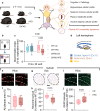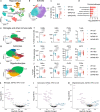N-acetylneuraminic acid links immune exhaustion and accelerated memory deficit in diet-induced obese Alzheimer's disease mouse model
- PMID: 36894557
- PMCID: PMC9998639
- DOI: 10.1038/s41467-023-36759-8
N-acetylneuraminic acid links immune exhaustion and accelerated memory deficit in diet-induced obese Alzheimer's disease mouse model
Abstract
Systemic immunity supports lifelong brain function. Obesity posits a chronic burden on systemic immunity. Independently, obesity was shown as a risk factor for Alzheimer's disease (AD). Here we show that high-fat obesogenic diet accelerated recognition-memory impairment in an AD mouse model (5xFAD). In obese 5xFAD mice, hippocampal cells displayed only minor diet-related transcriptional changes, whereas the splenic immune landscape exhibited aging-like CD4+ T-cell deregulation. Following plasma metabolite profiling, we identified free N-acetylneuraminic acid (NANA), the predominant sialic acid, as the metabolite linking recognition-memory impairment to increased splenic immune-suppressive cells in mice. Single-nucleus RNA-sequencing revealed mouse visceral adipose macrophages as a potential source of NANA. In vitro, NANA reduced CD4+ T-cell proliferation, tested in both mouse and human. In vivo, NANA administration to standard diet-fed mice recapitulated high-fat diet effects on CD4+ T cells and accelerated recognition-memory impairment in 5xFAD mice. We suggest that obesity accelerates disease manifestation in a mouse model of AD via systemic immune exhaustion.
© 2023. The Author(s).
Conflict of interest statement
M. Schwartz is a consultant of ImmunoBrain Checkpoint LTD. The remaining authors declare no competing interests.
Figures







Comment in
-
Obesity-associated immune exhaustion accelerates AD pathology.Nat Rev Neurol. 2023 May;19(5):257. doi: 10.1038/s41582-023-00805-2. Nat Rev Neurol. 2023. PMID: 37002365 No abstract available.
References
Publication types
MeSH terms
Substances
Grants and funding
LinkOut - more resources
Full Text Sources
Medical
Molecular Biology Databases
Research Materials

